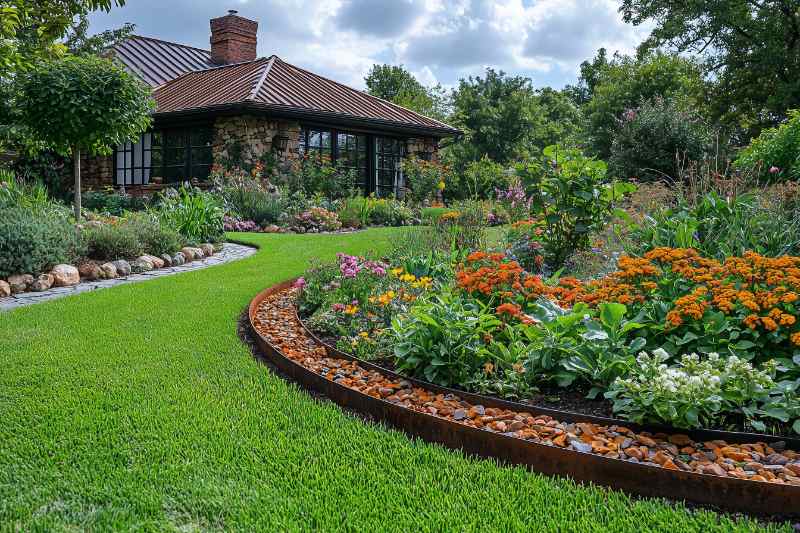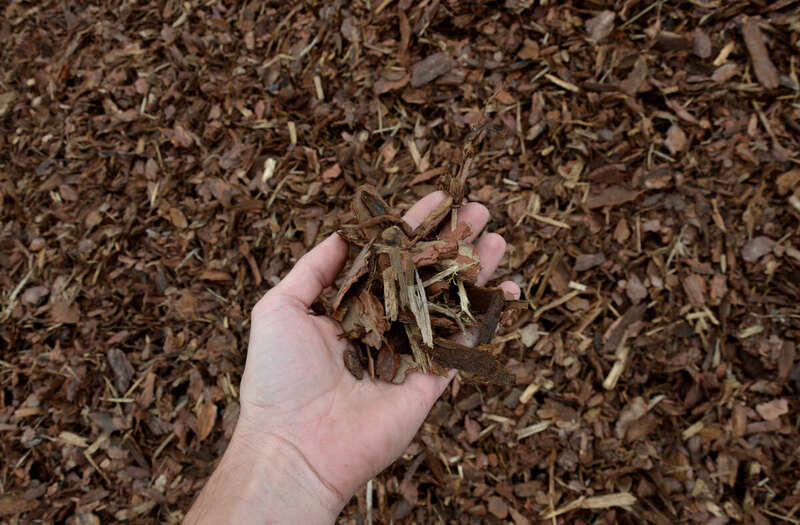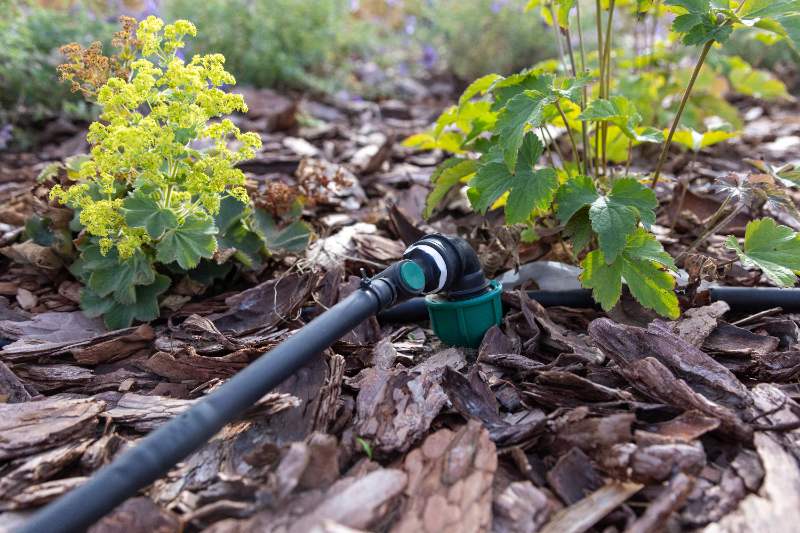
You can stop stressing over runaway mulch now. No matter the weather or slope, keep mulch in place by keeping it moist, installing proper edging, creating a mulch trench, or applying stabilizer.
After mulching your yard, you don’t want it to scatter all over the place. With the various techniques we’ll share here, you can prevent your mulch from being displaced. Plus, we also asked an expert for tips on how you can effectively keep mulch in place in your landscape.
1. Install Proper Edging

Apart from retaining soil moisture, mulch also has other purposes, including suppressing weed growth and preventing erosion. But it can run away from its responsibilities if you don’t keep it in place.
One solution is to install a sturdy garden edging, such as:
- Metal edging (steel or aluminum): Durable and flexible for curves — bury 4 to 6 inches deep, with a few inches above ground to hold mulch.
- Stone or brick: Durable and best for a natural look — lay in a shallow trench 4 to 6 inches deep.
- Wood edging (timber, planks, railroad ties): Rustic and budget-friendly — bury 3 to 5 inches deep, leaving a lip above to trap mulch.
- Plastic/rubber edging: Affordable and flexible — install in a trench 3 to 6 inches deep and tack down with spikes.
- Concrete curbing: Permanent and mower-tough — usually set 4 to 6 inches deep, it requires professional installation.
My Tip: Install edging deep enough to block roots and tall enough (2 to 4 inches above the soil) to contain mulch within the bed.
See Related: How Much Does Landscape Edging Cost?
2. Create a Mulch Trench
Homeowners who prefer a clean, built-in mulch barrier can create a mulch trench instead:
- Mark the edge of the landscape bed with a rope or spray paint.
- Use an edging shovel to dig a trench about 3 to 4 inches deep.
- Remove soil along the line and slope the trench, making the side of the bed slightly higher.
- Pack the trench soil tightly along the bed’s outer edge to create a firm barrier for mulch.
- For curves, soften the line by trimming the soil gently along the curve.
Optional: Add hardscaping, like a row of pavers or stones, inside the trench for extra hold.
Here’s a video on how to create a mulch trench:
3. Use Heavier Mulch Options

One of the easiest ways to keep mulch from washing away is to use heavy or interlocking types of mulch that naturally resist movement, such as:
- Shredded hardwood bark: Dense, slightly interlocking wood mulch that settles well.
- Cedar or pine bark nuggets: Heavier bark pieces that decay slowly.
- Rubber mulch: Made from recycled tires, rubber mulch is colorful, heavy, long-lasting, and great at staying in place.
- River rock or pea gravel: These inorganic mulches won’t easily wash away, but you’ll need to use the right type of landscape fabric underneath to prevent them from sinking into the soil.
My Tip: Don’t forget to check if your plants can tolerate the minerals or heat that rocks can bring.
| If you need to replace your mulch, hire a LawnStarter landscaping pro to do the work. Customers pay our pros an average of $286 for mulching services, and give them an average rating of 4.7. |
See Related: How to Choose the Right Mulch Color for Your Landscape
4. Remove Landscape Fabric and Plastic Sheeting
Apart from stopping mulch from sinking into the soil, plastic sheeting and landscape fabrics can also suppress weed growth, which is why many homeowners lay them underneath mulch. But if you don’t have proper edging in place, mulch can slip or roll off from the slippery plastic.
Instead of using slippery landscape fabrics or plastics, you can:
- Use cardboard or newspaper beneath mulch
- Crowd out weeds naturally with dense ground cover plants
- Opt for thicker organic mulch (3-4 inches) to control weeds without harming soil health
Using newspaper also has added benefits.
According to Michael Andruczyk, senior horticulture agent at the Virginia Cooperative Extension, “Wetting the newspaper will keep the wind from blowing it as easily, and after a few months covered by this mulch, it will break down to feed the soil too.”
5. Keep Mulch Moist

Keeping mulch slightly moist not only boosts plant health but also helps keep mulch in place.
Other benefits of moist mulch:
- Helps control erosion
- Retention of up to 80% soil moisture
- Suppression of weed seed germination by moderating soil temperature and blocking sunlight
Here are effective tips to keep mulch moist:
- Opt for moisture-retaining mulch like pine straw or shredded bark
- Install drip irrigation or soaker hoses to water the soil without washing off the mulch
- Water occasionally during dry spells, especially after heavy wind or heat exposure
My Tip: Old mulch can’t absorb or hold water effectively, so don’t forget to replace your organic mulch once it’s fading or you notice pests, diseases, or weeds.
6. Apply Mulch Stabilizer
Even if you know how to put mulch down, it’s not enough to prevent wind or stormwater runoff from ruining your hard work. Applying mulch stabilizer can help you avoid such a disaster.
Also known as a mulch glue or anchor, mulch stabilizer is a spray-on adhesive that binds mulch particles together, making the mulch resistant to wind and water. Andruczyk recommends checking the ingredients to see what the glue is made of and how it might affect adjacent plants or roots.
Always read and follow the instructions on the label, but here’s a general guide on applying mulch stabilizers:
- Remove any debris and rake the mulch to create a smooth, even layer. Compress it gently with your hands.
- Improve adhesion by lightly watering the mulch before spraying with stabilizer.
- Use a garden sprayer to apply an even coat of stabilizer over the mulch. Avoid spraying your plants.
- Let the first coat dry for 2 hours. You can then opt to apply a second coat.
- Avoid watering it for 24 hours while it cures.
Note: Mulch stabilizers typically hold mulch in place for 12 to 24 months before needing a re-coat.
7. Use Mulch Netting/Erosion Control Blanket
For steep slope landscaping, mulch netting or erosion control blankets can effectively hold mulch in place. If you place these blankets over your mulch, rain and gravity will find it hard to displace it.
Note: Biodegradable options like straw and coconut blankets work well for flower gardens, while plastic netting is better for high-traffic and erosion-prone areas.
8. Maintain Proper Mulch Depth
If you’re wondering how deep mulch should be, most experts recommend 2 to 4 inches for beds, shrubs, and trees. With insufficient mulch, weeds can still pop up. On the other hand, a thick layer of mulch can suffocate roots or hold excess moisture.
Here are some expert tips on how to maintain proper depth:
- Use a ruler to measure the depth at multiple spots, ensuring they’re even and around 2 to 4 inches deep.
- Spot-check mid-season, especially after heavy rain or wind, if needed.
- Add mulch to thinning areas, replace old mulch, or top it off annually in spring.
Avoid volcano mulching (piling mulch high around the base of trees) and pull mulch away from trunks to prevent rot:
- Young trees: 3 to 5 inches away
- Mature trees: 8 to 10 inches away
See Related: How to Mulch Around Trees
9. Strategic Planting
Plant placement can help anchor mulch and reduce displacement naturally, even on slopes. If you don’t know how to landscape a slope, you can start by choosing plants that anchor the soil and help mulch stay in place:
- Ground covers form a dense carpet that traps mulch under their foliage. Andruczyk says that using ground covers appropriate to the site situation could be the most time- and cost-effective solution.
- Mulch-friendly perennials have leafy mounds that act as mulch retainers at the soil edge.
- Shrubs with low branches can act as natural windbreaks and mulch barriers when strategically placed along bed edges.
- Bunch-type native grasses have dense bases that can help catch wind-blown mulch and stabilize the soil.
My Tip: Layer your plants by placing tall plants in the back, mid-sized shrubs in the middle, and ground covers on the front. This will create natural terraces that hold mulch.
FAQ About Keeping Mulch in Place
Shredded hardwood bark and rubber mulch are best for windy areas. Their heavier weight and interlocking texture help them stay in place better than lightweight options like straw or pine needles.
The most cost-effective way to keep mulch from washing away is to create a mulch trench or use natural edging like stone or logs already lying around your property.
Yes, most mulch stabilizers are non-toxic and plant-safe. They’re designed to let water and air through while anchoring mulch. However, it’s always best to double-check the label, especially if you’re using them near your backyard vegetable garden.
Steel or aluminum edging offers the best long-term mulch containment. It’s durable, low-profile, and curves easily around landscape beds.
Hire a Pro to Make Your Mulch Stay Put
Apart from protecting plants, conserving moisture, and fighting off weeds, mulch can also make a yard look neat. But you must keep it in its intended area.
And if you don’t want to spend your weekends digging trenches or wrestling with netting, hiring a LawnStarter landscaping pro is your best option. They know how to keep mulch in place and can also help with your other landscaping needs.
Sources:
- Michael Andruczyk, senior horticulture agent at the Virginia Cooperative Extension. Personal interview.
- “Mulch in the Landscape.” By Nicole Stoner, extension educator. University of Nebraska-Lincoln.
- “Mulches for the Landscape.” By Jeff Wilson, associate professor. Mississippi State University.
- “Mulching Garden Soils.” By David Hillock, senior extension specialist. Oklahoma State University.
- “Mulching Landscape Trees.” By David Jackson, former extension educator. Pennsylvania State University.
- “Mulching Trees and Shrubs.” University of Maryland Extension.
Main Image: Rocks don’t wash away as easily as wood mulch during rain. ROY / Adobe Stock generated with AI